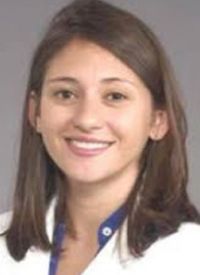Thrombotic Microangiopathy a Threat After Hematopoietic Cell Transplant
Transplant-associated thrombotic microangiopathy occurred in as many as 36% of hematopoietic cell transplants and significantly increased the risk of transplant-related mortality.
Michelle Schoettler, MD

Michelle Schoettler, MD
Transplant-associated thrombotic microangiopathy (TA-TMA) occurred in as many as 36% of hematopoietic cell transplants (HCTs) and significantly increased the risk of transplant-related mortality (TRM), a review of more than 300 cases showed.
Retrospective application of Jodele diagnostic criteria showed that TA-TMA occurred in 110 of 307 HCT procedures. By Cho criteria, 62 patients developed TA-TMA. Diagnosis by either criterion was associated with worse overall survival.
Elevated LDH and increasing number of antihypertensive medications correlated with worse outcomes among patients with TA-TMA, as reported at the 2019 Transplantation & Cellular Therapy Meetings.1
“TMA is a frequent complication of both allogeneic and autologous transplantation,” said Michelle Schoettler, MD, of Dana-Farber Cancer Institute and Boston Children’s Hospital. “TMA, by either diagnostic criteria, is associated with decreased overall survival and increased transplant-related mortality. We propose that patients with LDH greater than or equal to two times the upper limit of normal (ULN) or requiring two or more antihypertensive medications…may aid providers who do not have complement studies that can have results quickly.”
TA-TMA complicates about 30% of HCT procedures and confers a mortality risk in excess of 50%. The condition is a diagnostic challenge and is a clinical diagnosis in most cases.
Two sets of diagnostic criteria for TM-TMA have been published. By the Cho criteria, a probable diagnosis of TA-TMA requires the presence of schistocytes, increased LDH, thrombocytopenia or need for platelet transfusion, anemia or need for red blood cell transfusion, and a negative Coombs test.2
More recently, Jodele et al proposed alternative TM-TMA diagnostic criteria, comprising all but the negative Coombs test from Cho, plus age-defined hypertension, proteinuria, and terminal complement activation.3 A diagnosis of TM-TMA required that a patient meet four of the seven criteria.
Schoettler and colleagues performed a retrospective analysis that aimed to describe the prevalence and outcomes of TA-TMA by both the Cho and Jodele criteria, determine whether TA-TMA is independently associated with TRM, and identify features associated with TRM in patients with TA-TMA.
The 307 patients included in the analysis had a median age of 7.5 years (range, 0.1 month to 27.3 years), 64% were male, and 67% of the patients underwent allogeneic HCT. Application of the Cho criteria resulted in the identification of 62 cases of TA-TMA. The Jodele criteria identified the same 62 patients plus an additional 48 for a total of 110. In 10 cases, providers prospectively diagnosed TA-TMA on the basis of clinical findings. None of the retrospectively identified patients received TMA-directed therapy, said Schoettler.
By the Cho criteria, diagnosis of TA-TMA was significantly (P <.05) associated with longer hospital admissions, more ICU admissions, a higher incidence of engraftment failure, higher rates of acute graft versus host disease (aGVHD), lower overall survival, and increased TRM. Patients who met TMA criteria had a 1-year overall survival of 74% compared with 92.6% for patients without TMA. The 1-year TRM was 16.9% versus 1.3%.
Multivariate analysis identified TA-TMA as the strongest predictor of TRM (HR, 4.1; P = .003), followed by grade 3/4 aGVHD (HR, 3.3; P = .048).
Diagnosis of TA-TMA by the Jodele criteria had significant (P <.05) associations with increased days in hospital, increased ICU admissions, increased risk of aGVHD, decreased survival, and increased TRM. The 1-year overall survival was 78.5% in patients with TA-TMA and 94.1% for patients without a TMA diagnosis. The 1-year TRM was similar to that observed with diagnosis by Cho criteria.
Multivariate analysis again identified TA-TMA (HR, 14.5; P = .0006) and grade 3/4 aGVHD (HR, 3.5; P = .01) as independent predictors of TRM.
A separate analysis of risk factors for TRM among patients with TA-TMA identified only 2 significant predictors: LDH ≥2 ULN (HR, 4.5; P = .003) and need for 2 or more antihypertensive medications (HR, 11.1; P <.0001).
Schoettler and colleagues performed separate analyses of outcomes by Jodele criteria for patients undergoing allogeneic or autologous HCT procedures. Patients with diagnoses of TA-TMA after allogeneic HCT had significantly worse 1-year overall survival (P <.0001) and TRM (P <.0001). Additionally, LDH ≥2 ULN (P = .0109) and need for two or more antihypertensives (P =.0012) were significantly associated with TA-TMA.
Among patients who underwent autologous HCT procedures, 1-year overall survival did not differ significantly between patients with and without TA-TMA. However, 1-year TRM remained significantly worse for patients with TA-TMA (P <.0001).
References
- Schoettler ML, Lehmann LE, Margossian S, et al. Transplant associated thrombotic microangiopathy (TA-TMA): lessons learned from a large pediatric center. Presented at: TCT Meetings; February 20-24, 2019; Houston, TX. Abstract 22.
- Cho BS, Yahng SA, Lee SE, et al. Validation of recently proposed consensus criteria for thrombotic microangiopathy after allogeneic hematopoietic stem-cell transplantation. Transplantation. 2010;90(8):918-926. doi: 10.1097/TP.0b013e3181f24e8d.
- Jodele S, Davies SM, Lane A, et al. Diagnostic and risk criteria for HSCT-associated thrombotic microangiopathy: a study in children and young adults. Blood. 2014;124(4):645-653. doi: 10.1182/blood-2014-03-564997.
<<< 2019 Transplantation and Cellular Therapy Meetings
The analysis comprised all patients who underwent HCT at a single institution from January 2015 to July 2017. The two sets of diagnostic criteria were retrospectively applied to each patient during follow-up to day +100. The analysis included allogeneic and autologous transplantation procedures.



